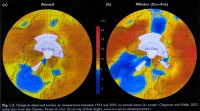By Tim Ball, Senior Fellow
The state of the Arctic sea ice is the topic of voluminous media reports about the effects of climate change.
> An analysis of the coverage shows that several aspects of Arctic phenomena make it a prime candidate for media stories.
> Media reporting on any issue has a self-sustaining momentum. Once a story has broken, a feedback loop leading to more stories ensues. Reporters know the issue has a waiting audience, and the public seeks reports that fit into its framework of understanding.
> Contrary to the underlying assumption of uniformitarianism on which Western environmental science is based, the environment regularly goes through significant and non-linear changes. Because we know little about the Arctic (satellite surveillance has only given reliable measurements of Arctic sea ice since 1979), it is very easy to contrast the constantly changing Arctic with the normal expectation of a changeless or incrementally changing environment.
> The Arctic is home to a number of animals including wolves and polar bears that are regularly used to invoke human pity.
> Changes in climate tend to create their strongest signals at the temperature-extreme poles.
> Contrary to the cautious and conditional approach of scientific progress, media reports on scientific matters tend to present speculation as fact, and reporters protect themselves against misstatement with neutral admissions of uncertainty. By examining a typical media story about the Arctic sea ice paragraph by paragraph, we can see how these and other techniques are used to present an emotionally compelling story that is completely disconnected from what scientists actually understand.
Arctic and Antarctic regions receive a great deal of attention for several reasons: a) we know very little about them b) they are regions where the greatest warming due to human CO2 is predicted c) they are home to animal species that have been used to exploit our emotions from Walt Disney’s false representation of lemmings in White Wilderness to Kevin Costner’s Dances with Wolves to Al Gore’s complete misrepresentation of polar bears to the more accurate but very emotional portrayal of Antarctic penguins.
Direct observation of and reports about the Arctic effectively began in the 16th century. Reports from that time are limited, but more importantly, an accurate determination of the extent of the Arctic sea ice did not exist prior to 1979. Climate data for the Arctic Ocean simply does not exist as is shown by the large “No Data” sections in the map from the Arctic Climate Impact Assessment (ACIA) for the period 1954 to 2003. Indeed, the fundamental argument made in that assessment for millions of research dollars was precisely because so little is known. It is important to note that the findings of the ACIA were the basis of understanding, assessment and recommendations for the 2007 Intergovernmental Panel on Climate Change report.

See larger image here.
Read the full report here.




